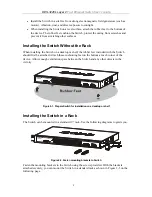
DES-3226L Layer 2
Fast Ethernet Switch User’s Guide
SECTION 1
Introduction
Ethernet Technology
Switch Description
Features
Ports
Front-Panel Components
Side Panel Description
Rear Panel Description
Gigabit Combo Ports
Ethernet Technology
Fast Ethernet Technology
The growing importance of LANs and the increasing complexity of desktop computing
applications are fueling the need for high performance networks. A number of high-speed
LAN technologies are proposed to provide greater bandwidth and improve client/server
response times. Among them, Fast Ethernet, or 100BASE-T, provides a non-disruptive,
smooth evolution from 10BASE-T technology.
100Mbps Fast Ethernet is a standard specified by the IEEE 802.3 LAN committee. It is an
extension of the 10Mbps Ethernet standard with the ability to transmit and receive data at
100Mbps, while maintaining the Carrier Sense Multiple Access with Collision Detection
(CSMA/CD) Ethernet protocol.
Gigabit Ethernet Technology
Gigabit Ethernet is an extension of IEEE 802.3 Ethernet utilizing the same packet structure,
format, and support for CSMA/CD protocol, full duplex, flow control, and management
objects, but with a tenfold increase in theoretical throughput over 100Mbps Fast Ethernet and
a one hundred-fold increase over 10Mbps Ethernet. Since it is compatible with all 10Mbps
and 100Mbps Ethernet environments, Gigabit Ethernet provides a straightforward upgrade
without wasting a company’s existing investment in hardware, software, and trained
personnel.
The increased speed and extra bandwidth offered by Gigabit Ethernet are essential to coping
with the network bottlenecks that frequently develop as computers and their busses get faster
and more users use applications that generate more traffic. Upgrading key components, such
as your backbone and servers to Gigabit Ethernet can greatly improve network response times
as well as significantly speed up the traffic between your subnetworks.
Gigabit Ethernet enables fast optical fiber connections to support video conferencing,
complex imaging, and similar data-intensive applications. Likewise, since data transfers occur
1














































